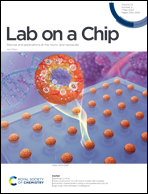Temporal sorting of microdroplets can identify productivity differences of itaconic acid from libraries of Yarrowia lipolytica†
Abstract
Microdroplet screening of microorganisms can improve the rate of strain selection and characterization within the canonical design–build–test paradigm. However, a full analysis of the microdroplet environment and how well these conditions translate to culturing conditions and techniques is lacking in the field. Quantification of three different biosensor/analyte combinations at 12 hour timepoints reveals the potential for extended dose–response ranges as compared to traditional in vitro conditions. Using these dynamics, we present an application and analysis of microfluidic droplet screening utilizing whole-cell biosensors, ultimately identifying an altered productivity profile of itaconic acid in a Yarrowia lipolytica-based piggyBac transposon library. Specifically, we demonstrate that the timepoint for microdroplet selection can influence the outcome of the selection and thus shift the identified strain productivity and final titer. In this case, strains selected at earlier timepoints showed increased early productivity in flask scale, with the converse true as well. Differences in response indicate microdroplet assays require tailored development to more accurately sort for phenotypes that are scalable to larger incubation volumes. Likewise, these results further highlight that screening conditions are critical parameters for success in high-throughput applications.



 Please wait while we load your content...
Please wait while we load your content...